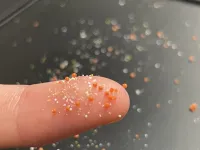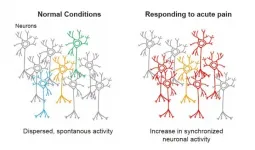Spanish-speaking children experience higher rate of obesity than English-speaking children
Childhood obesity also more prevalent among U.S. households with low socioeconomic status
2021-03-20
(Press-News.org) WASHINGTON--Nearly one in five U.S. children and teenagers has obesity, and statistics show a higher prevalence of obesity in certain ethnicities, such as Hispanics and Blacks. Now results of a study being presented at ENDO 2021, the Endocrine Society's annual meeting, suggest that Spanish as a family's primary language is a predictor of childhood obesity, regardless of ethnicity.
The prevalence of obesity among children and teens from Spanish-speaking households in the nation was 24.4 percent, approximately 50 percent higher than those from English-speaking households, according to results of a new analysis of the U.S. National Health and Nutrition Examination Survey. This survey examines a nationally representative sample of the U.S. population each year, and the study researchers used statistics from the 1999 to 2018 surveys regarding 2- to 19-year-olds. The survey found overall obesity among this age group climbed to 19.2 percent in 2018, up from 14.7 percent in 1999.
"Childhood obesity is associated with multiple diseases in adulthood," said the Hang-Long ("Ron") Li, a medical student at the University of Hong Kong (HKU) LKS Faculty of Medicine in Hong Kong, China, who carried out the analysis under the supervision of Prof. Bernard M.Y. Cheung, Ph.D., the Sun Chieh Yeh Heart Foundation Professor in Cardiovascular Therapeutics at HKU. "Public health measures specifically catering to children from Spanish-speaking families should be put in place to raise awareness of childhood obesity and implement health interventions."
Li said they are the first group to identify an association between childhood obesity and language. He speculated that language barriers could prevent Spanish-speaking families from understanding health education materials or accessing Spanish-language health promotion resources. Additionally, he noted that food labels, which play an important role in obesity prevention efforts, may be in English only. Alternatively, these families may be aware of available health materials but are not taking action to make essential lifestyle changes.
Existing programs to combat childhood obesity should be promoted to Spanish-speaking households and should be sensitive to different cultural traditions, Li said.
"Health talks and activities could also be carried out in Spanish to improve the dissemination of important public health knowledge, such as healthy eating and physical activity," he said.
The researchers also found that obesity is more prevalent in children from households with a low socioeconomic status. The obesity rate was 23.8 percent in children from low-income households versus 11 percent for children in high-income households, they reported. Likewise, the prevalence of obesity was 26.2 percent in children from households with a low educational level compared with 9.4 percent from highly educated families.
Measures to halt this trend could include promotion of healthy school meals and improved accessibility and affordability of nutritious fresh foods in poor communities, Li said.
The researchers looked at U.S. trends in childhood obesity over the last two decades and found a large increase in overall obesity among 2- to 19-year-olds. Severe obesity at those ages increased from 3.9 to 6.1 percent in the same period, a more than 55 percent upsurge, Li reported.
In children, severe obesity is weight at or above the 120th percentile for age and sex, and the definition of obesity is weight at or greater than the 95th percentile.
"Improved public health interventions are urgently needed to halt the rising trend of childhood obesity," Li said.
INFORMATION:
Endocrinologists are at the core of solving the most pressing health problems of our time, from diabetes and obesity to infertility, bone health, and hormone-related cancers. The Endocrine Society is the world's oldest and largest organization of scientists devoted to hormone research and physicians who care for people with hormone-related conditions.
The Society has more than 18,000 members, including scientists, physicians, educators, nurses and students in 122 countries. To learn more about the Society and the field of endocrinology, visit our site at http://www.endocrine.org. Follow us on Twitter at @TheEndoSociety and @EndoMedia.
ELSE PRESS RELEASES FROM THIS DATE:
2021-03-20
Tokyo, Japan - Researchers from Tokyo Metropolitan University have devised and implemented a simplified algorithm for turning freely drawn lines into holograms on a standard desktop CPU. They dramatically cut down the computational cost and power consumption of algorithms that require dedicated hardware. It is fast enough to convert writing into lines in real-time, and makes crisp, clear images that meet industry standards. Potential applications include hand-written remote instructions superimposed on landscapes and workbenches.
Flying cars, robots, spaceships...whatever sci-fi future you can imagine, there is always a common feature: holograms. ...
2021-03-20
Researchers from Columbia University and Temple University published a new paper in the Journal of Marketing that examines how choice architecture can reduce socioeconomic disparities.
The study, forthcoming in the Journal of Marketing, is titled "Do Nudges Reduce Disparities? Choice Architecture Compensates for Low Consumer Knowledge" and is authored by Kellen Mrkva, Nathaniel Posner, Crystal Reeck, and Eric Johnson.
As Mrkva explains, "Our research demonstrates that people with low socioeconomic status (SES), low numerical ability, and low knowledge are most impacted by nudges. As a result, 'good nudges,' designed to encourage ...
2021-03-19
It's estimated that an average-sized wastewater treatment plant serving roughly 400,000 residents will discharge up to 2,000,000 microplastic particles into the environment each day. Yet, researchers are still learning the environmental and human health impact of these ultra-fine plastic particles, less than 5 millimeters in length, found in everything from cosmetics, toothpaste and clothing microfibers, to our food, air and drinking water.
Now, researchers at New Jersey Institute of Technology have shown that ubiquitous microplastics can become 'hubs' for antibiotic-resistant bacteria ...
2021-03-19
ROCHESTER, Minn. -- Low representation of minority groups in public genomic databases may affect therapy selection for Black patients with cancer, according to new Mayo Clinic research published in npj Precision Oncology.
The researchers investigated the use of genomic databases and found that tumor mutation burden was significantly inflated in Black patients compared to White patients.
As a result of the study, clinicians who are using public genomic databases need to be aware of the potential for inflated tumor mutation burden values and how that may affect therapy selection and outcomes, especially for patients from underrepresented groups.
Clinicians use biomarkers, which are indicators of a disease or condition, to determine ...
2021-03-19
BOSTON - Researchers have used a genetic engineering strategy to dramatically reduce levels of tau--a key protein that accumulates and becomes tangled in the brain during the development of Alzheimer's disease--in an animal model of the condition. The results, which come from investigators at Massachusetts General Hospital (MGH) and Sangamo Therapeutics Inc., could lead to a potentially promising treatment for patients with this devastating illness.
As described in Science Advances, the strategy involves a gene regulation technology called zinc finger protein transcription ...
2021-03-19
A team of scientists, led by researchers at Northwestern University, Shirley Ryan AbilityLab and the University of Illinois at Chicago (UIC), has developed novel technology promising to increase understanding of how brains develop, and offer answers on repairing brains in the wake of neurotrauma and neurodegenerative diseases.
Their research is the first to combine the most sophisticated 3-D bioelectronic systems with highly advanced 3-D human neural cultures. The goal is to enable precise studies of how human brain circuits develop and repair themselves in vitro. The study is the cover story for ...
2021-03-19
In a world first, a cross-institutional research collaboration has used a two-photon microscope (*1) with a combination of calcium imaging (*2) and holographic stimulation (*3) to reveal that the functional connectivity between neurons located in the primary somatosensory cortex is increased in response to acute pain.
Pain occurs as a result of injury, such as peripheral neuron damage or inflammation stemming from peripheral tissue violation. Research findings have been published on the involvement of central nervous system abnormalities in the onset of pain and sustained pain. The primary somatosensory cortex ...
2021-03-19
COLUMBUS, Ohio - Most stroke victims don't receive treatment fast enough to prevent brain damage. Scientists at The Ohio State University Wexner Medical Center, College of Engineering and College of Medicine have developed technology to "retrain" cells to help repair damaged brain tissue. It's an advancement that may someday help patients regain speech, cognition and motor function, even when administered days after an ischemic stroke.
Engineering and medical researchers use a process created by Ohio State called tissue nanotransfection (TNT) to introduce genetic material into cells. This allows them to reprogram skin cells to become something ...
2021-03-19
New York, NY--March 19, 2020--Columbia Engineering researchers, working with Brookhaven National Laboratory, report today that they have built designed nanoparticle-based 3D materials that can withstand a vacuum, high temperatures, high pressure, and high radiation. This new fabrication process results in robust and fully engineered nanoscale frameworks that not only can accommodate a variety of functional nanoparticle types but also can be quickly processed with conventional nanofabrication methods.
"These self-assembled nanoparticles-based materials are so resilient that they could fly in space," says Oleg Gang, professor ...
2021-03-19
PITTSBURGH, March 19, 2021 - Non-circulating memory T cells, whose main function is to provide local protection against re-infection, contribute to chronic transplant rejection, University of Pittsburgh School of Medicine researchers reveal in a paper published today in Science Immunology.
The scientists show that these "tissue-resident memory T cells" are harmful in situations where antigens that the cells recognize are present in the body for a long time, such as in cases of an organ or tissue transplant. This finding is an important step toward improving therapies to help prevent organ rejection in transplant recipients.
"Tissue-resident memory T cells serve an important surveillance function," said co-senior author Martin Oberbarnscheidt, ...
LAST 30 PRESS RELEASES:
[Press-News.org] Spanish-speaking children experience higher rate of obesity than English-speaking children
Childhood obesity also more prevalent among U.S. households with low socioeconomic status



